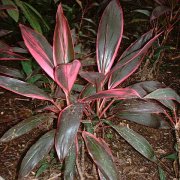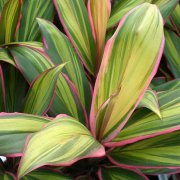Care of the indoor plant Cordyline fruticosa or Ti plant |
|
The genus Cordyline, family Asparagaceae, comprises 12 species of evergreen trees and shrubs native to Australia, India, New Zealand, and Polynesia. Some species are: Cordyline fruticosa, Cordyline australis, Cordyline dracaenoides, Cordyline indivisa, Cordyline stricta. Common names: Ti plant, Tiplant, Palm lily, Cabbage palm, Good luck plant. This species is native to Southeast Asia. They are tropical shrubs that do not usually exceed 1 meter (3.28 feet) in height in the garden. They are very interesting for their large lanceolate leaves (up to 40 cm/15.74" in length) of green, cream, red and purple color (depending on the variety). They do not usually flower since the plant does so after 10 years of life. Ti plant is used as indoor plants in pots planted with other smaller plants in the same pot to provide environmental humidity. In humid tropical or subtropical climates it's grown in the garden as an isolated specimen or in small groups. Cordyline fruticosa needs a light exposure but no direct sun. Green varieties grow well in shaded exposures. Avoid sudden changes in temperature and drafts. The winter temperature should not be lower than 15 ºC (59 ºF). The soil can be a mixture of forest soil, leaf mulch, and siliceous sand for good drainage. Palm lily is usually transplanted every 3 years in early spring. Outdoors water moderately especially if the weather is humid. Indoors, water with lime-free water when the substrate surface has dried. High humidity is important: spray the plant every day with lime-free water; in winter reduce watering but keep sprayed. Fertilize with mineral fertilizer for indoor plants once a month in spring and summer; in autumn and winter fertilize every 3 months. Good luck plant does not need pruning; If the plant loses many leaves, it is advisable to prune it 30 cm (11.8") from the base so that it regrows. If the humidity is low, they can be attacked by aphids. Palm lily propagates from the suckers that the plant produces at its base or by cuttings from the tip of the stem (only in specimens of several years). |
Images of the indoor plant Cordyline fruticosa or Ti plant |
Find plants
Cordyline fruticosa or Ti plant | Care and Growing
© 2025 FavThemes





